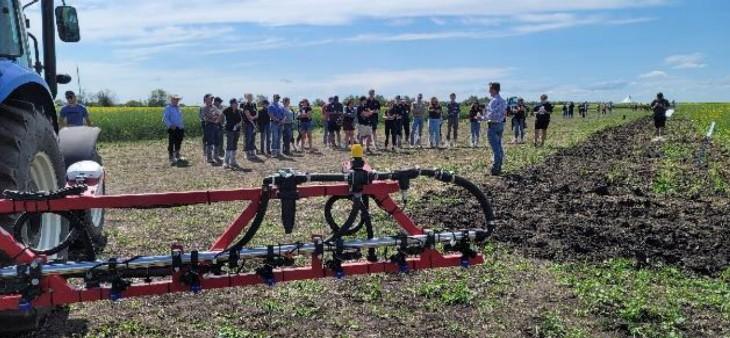

From full coverage to spot control: Smarter spraying starts here
Research Team
Dr. Haider Abbas, crop research scientist, Lakeland College, led this field-based research project with his crop team at Vermilion and in-kind support from Croplands Equipment.
Summary
As no-tillage and minimum-tillage practices take root across Canadian grain farms, they've brought a wave of benefits such as reducing soil erosion, improving soil structure, and boosting water efficiency. But there's a twist. These soil-saving methods have reshaped weed dynamics. The result? Weed resistance and shrinking options for effective control.

Herbicide-resistant weeds aren’t just a future threat, they're a new normal, and hurt profitability. So, what are farmers to do if they do not want to revert to the tillage for weed control?
Precision Spot Spraying offered us a pre-burn solution. Leveraging green on brown smart tech to lock onto weeds and spray only where needed. The Weed-IT sprayers used in this project are equipped with state-of-the-art modular sensors mounted on the boom, capable of scanning the soil and crop residue 7,000 times per second—even while moving at speeds of up to 16 mph (25 kph). This advanced “green-on-brown” technology detects chlorophyll in real time, allowing the system to identify and target only living weeds against a non-vegetative background. As soon as a weed is detected, individual nozzles activate instantly to deliver a precise dose of herbicide. The result is smarter, more efficient weed control—reducing chemical usage, cutting input costs, and delivering measurable gains in sustainability and productivity for modern farming operations.

This precision spraying strategy saves money, decreases input and enhances productivity. Yet, adoption lags. The future of farming demands smarter cleaner and more efficient solutions that combine economic and ecological priorities. Spot-spraying appears to offer both and is deserving of consideration in all crop applications, herbicide, fertilizer and insecticides.
Methodology

In 2023 and 2024, Lakeland College’s Crop Team conducted field-based pre-burn trials using Conquer II + RT540 in canola to assess the economic benefits of the spot sprayer. Technology was also featured in live field demonstrations during Lakeland College Field Day, designed to inform and engage local growers.
Results
Trial results showed that blanket spraying cost $15.89 per acre. The dual spray approach, which combines a blanket spray with an additional spot spray (1.5x rate) on detected weeds, was slightly more expensive at $17.08 per acre.
But here’s the surprising part: over two years, spot spraying alone not only costs less and reduced herbicide use by up to 86 per cent, it also improved average yields, delivering five per cent more than blanket spray and seven per cent more than dual spray.
Key takeaway: Spot spraying appears to be not only a cost-saving strategy to control herbicide-resistant weeds; it could also enhance yield performance.

Why it’s important: Giving producers the tools to turn insight into impact

Precision spot spraying is rewriting the rules of weed management. Unlike traditional blanket spraying, this cutting-edge technology pinpoints and targets only the weed. It dramatically cuts herbicide use, reducing environmental impact and costs, with fewer refills and faster application. Spot sprayer isn’t just a pre-burn tool collecting dust the rest of the year; it’s a season-long asset. From in-crop passes with selective herbicides, micronutrients, or bio-stimulants, to fungicide applications and even desiccation, it targets only the green, cutting waste and making every drop count. While the advantages are evident, the adoption of this technology across North America remains modest. Farmers cite steep upfront costs (52 per cent) and uncertain returns (40 per cent) as roadblocks to embracing these smart systems. However, given the strong triple bottom line argument, precision tools like Weed-it deserve attention.
What’s next
The 2023 and 2024 yield data show variation across multiple spray modes (blanket, dual, and spot) and have prompted a project to conduct a comprehensive soil analysis of microbial activity under these different spraying methods. The research results from this trial will correlate with findings from the new project examining the impact of herbicide use on microbes. According to the literature, herbicides can reduce the diversity and abundance of crucial soil microorganisms, which play essential roles in nutrient cycling and organic matter decomposition. These findings will help us better understand the impact of herbicides on microbial populations and their potential effect on yield. The environmental impact of different spray modes will also play a crucial role in the broader adoption of this technology.
